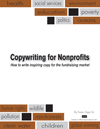I like email. I like sending text messages. And I use both extensively. Yet neither of them grabs my attention like seeing someone’s handwriting on an envelope or note card that I receive.
 This is one reason I don’t believe direct mail will ever die, because it’s how we send each other handwritten notes, cards and letters.
This is one reason I don’t believe direct mail will ever die, because it’s how we send each other handwritten notes, cards and letters.
And in the nonprofit world, I also believe sending a handwritten note is one of the most effective forms of cultivation available.
.
Don’t think handwriting is important?
Let me ask you this: Would you send a sympathy card with a typed message on the inside? If you answered “yes,” I’d be stunned and deeply disappointed.
Why exactly is the handwritten note so powerful? Why does it make a BIG impact on your donors?
• Handwritten messages take more time to create – the manual writing; the care to not misspell because ‘spellcheck’ isn’t available; and the time to write neatly so it can be easily read.
• Handwriting isn’t easy or time efficient. That’s partly why it’s exceptional.
• It costs more – and people know this – especially as compared to email, text messages or a social media update/message. The stationery, the stamps, and the logistics of getting it mailed all add to the cost.
• There’s something very personal about handwriting. It’s “real.”
• Personal handwritten messages stand out in a world of fast, digital communications.
• The handwritten note is becoming a lost art. How sad.
• It’s not only the elderly that appreciate the gesture.
• A well-crafted handwritten note shows a deeper investment and level of appreciation than a simple thank-you is able to do. But please don’t limit your use of handwriting notes to thank-you messages.
• It’s tangible. It’s more memorable than email, text or other digital messages.
• It adds up to this: Handwriting communicates value – specifically, that YOU value the donor
Perhaps you’re thinking: Who has time for this?
First off; I realize your time is limited. Whose isn’t?
Yet that’s precisely why a handwritten note is such a marvelous cultivation strategy.
Whether it’s adding a handwritten note onto a typed letter . . . or writing a handwritten thank-you card . . . or enclosing a handwritten note to a major donor with an article on a topic of great interest to them . . . or anything in between, you send a loud and clear message that you value the donor receiving your handwritten message.
I believe everything you do is cultivation. This strategy of weaving handwritten notes into your donor communications is unique. It’s worth making the time to do it – to find a way to make it a regular part of your stewardship and fundraising.
That’s not all. Sincere, thoughtful and consistent cultivation increases loyalty, donor life-time value, retention, and your total funds raised. Remember: High touch trumps high tech when it comes to warm, personalized cultivation and fundraising. Direct mail delivers this high touch.
8+ ways to better serve and cultivate donors and members
Donors and Teddy Bears Have a Lot in Common
6 Top Cultivation Methods (AKA: Stewardship)
This resource may also help you cultivate mid-level and major donors with a clever, personalized style. You can buy a batch of custom made cards, or have them do it all for you – even write the “handwritten” message … BlackSheepPostal.com
—————–
Photo Credit: “SweetOnVeg” via PhotoPin.com

{ 4 trackbacks }
{ 2 comments… read them below or add one }
Love this post! Handwritten thank you notes really go the extra mile, allowing donors and volunteers to see how you appreciate their hard work, dedication and time.
If you’re fundraiser helps support children, you could also have the children being helped write thank you cards as well. It adds a personal touch as to why money is being raised and shows how everyone involved is appreciative of their support.
Thanks “ShopBidGive” for weighing in, and for your kind words. Also like your suggestion of having the beneficiaries of the mission write the thank you notes when possible. Really drives home the personal touch!